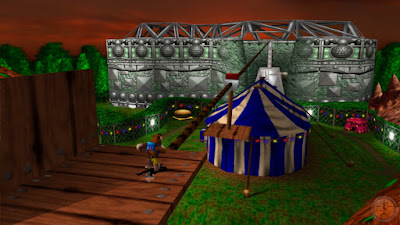To Z or not to Z
For the longest time I've had a love-hate relationship with the Dragon Ball Z franchise. For one, I really enjoyed and loved playing the games, no matter if they were 2D or 3D fighters, or something else completely out of left field. Collecting figurines as my younger self was also an entertaining hobby. However, the actual anime, at least the original version with all of its filler, was a show that was a bit difficult to watch. Thankfully, Dragon Ball Z Kai is doing a lot to fix the issues I had with the original anime.
Once more, a new Dragon Ball Z game enters the gaming atmosphere, this time landing on the Nintendo 3DS of all platforms. Though the system was rich in fighters in its early life, lately the fighting game scene is one that has avoided the platform. With Dragon Ball Z: Extreme Butoden, the Dragon Ball Z fighting game series reaches the 3DS with a Kamehameha Blast of epic proportions.
 |
| Krillin is here today to show that size doesn't matter. |
My personal favorite of the modes, and that's because of how much more expansive it is, is Adventure Mode. In Adventure Mode, you take the role of Goku who has to collect seven special Dragon Balls in order to combat the return of a plethora of old villains from Dragon Ball and Dragon Ball Z. To do this, you travel across eight unique maps, doing battle with AI opponents, and depending on how well you do in each fight, you earn items and new assist characters to your arsenal. Getting an S rank in a fight depends on whether you fulfill the mission's conditions (e.g. finish a foe with an Ultimate Combo, beat the opposing side within a specific amount of time, and so forth) and if you reach 400 points or more through doing a mix of Super Combos, summoning assist characters, and getting Rush Combos, multiple hits on an enemy at once.
 |
| An example of one of the maps used in Adventure Mode. |
25 characters might seem like a small amount, especially when compared to the 3D games, where we've definitely been a bit spoiled. However, the variety of characters in Extreme Butoden is rather high, and considering how the game uses 2D sprites for the fighters and assist characters instead of 3D models, it's easier to understand why the number of fighters is considerably less than the console games. Such combatants this go around include mainstays like Goku, Gohan, Piccolo, Vegeta, Trunks, and Krillin, plus villains like Raditz, Nappa, Frieza in his final form, Perfect Cell, Android 18, Majin Buu, and more.
 |
| Do androids dream of electric Saiyans pounding them in the jaw? |
 |
| Summon assist characters into the fray to turn the tide of battle... or to ensure victory. |
When more than one fighter is on a team, you can switch between them on the fly with the touch screen. Of course, like using assist characters, there is a cool down period before a fighter can return to battle. Each fighter has a Spirit Gauge which dictates how much energy can be used on special attacks that utilize Spirit, such as Goku's Kamehameha Blast and Vegeta's Galick Gun. The maximum a Spirit Gauge can ordinarily reach is 150%, but when a side's health gauge is at less than half, this can expand to 200%, allowing for greater moves and abilities in combat. Different moves take off different percentages of the Spirit Gauge, but the amount of the gauge can be restored through attacking the opponent as well as powering up via holding down the R button.
 |
| Goku gives a Kamehameha Blast up close and personal to Captain Ginyu. |
 |
| Ultimate attacks like this are huge spectacles, but they get annoying after the tenth time seeing them. |
Extreme Butoden sports extremely well articulated and detailed 2D sprites, showing Arc System Works at its finest. The amount of different animations and poses for each of the game's 25 fighters and 100 or so assist characters is extraordinary. The game uses 3D backgrounds that house some impressive features to them as well. The 3D effect of the Nintendo 3DS for this game is pretty tame. The Spirit Gauge is the sole piece of the game's graphics that stands out while everything else on the screen looks as if you're looking into a box. I wish there was more depth in the 3D effect, such as characters and the foreground popping out at the viewer against the backgrounds and environment. The music is comparative to past Dragon Ball Z games, featuring the token amount of rock and tense music for battles. Unfortunately, the English cast of the series is not represented in Extreme Butoden, only offering the Japanese cast instead.
 |
| Piccolo isn't preparing a special move. He's just showing off with a pose. |
[SPC Says: B-]







































